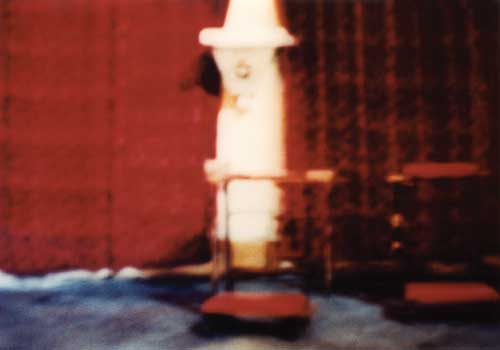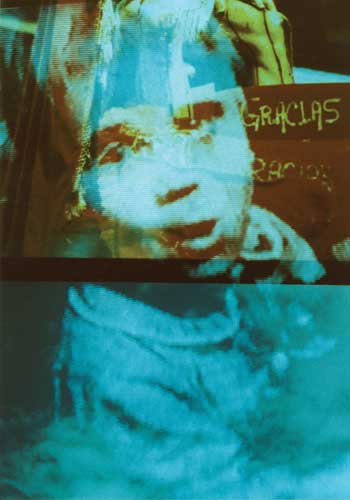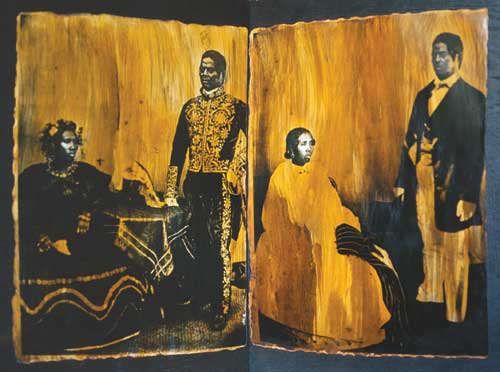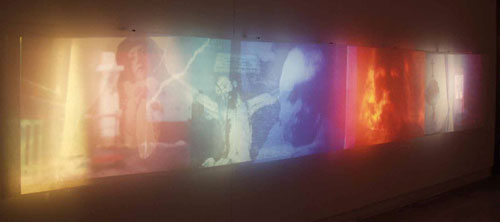


Foto © Izabela Jaroszewska - My dreams, Photoinstallation and detail.


Foto © Izabela Jaroszewska - My dreams, Photoinstallation and detail.
A CATALOGUE OF MEMORIES
Memory is a screen of consciousness composed of all possible
associations, which gives us an opportunity to create new, unreal
worlds. Using a photographic camera I can transform the existing
reality into my own new World. I create pictures that combine
various branches of visual arts (like film, photography and
painting). My photographic research prompted me to put together
"A Catalogue of Memories", which is an attempt to photograph
images of memory, images connected with specific events and
experience - mainly from my childhood. Those images are
transitory, unclear and fragmentary - like the images of our
memory.
Memory is a "chest" inside which everything that once was
conscious changes into something unconscious. Remembering is this
process in reverse. We try to recall what is unconscious and make
it conscious again. Memories are unclear, deformed, covered with
layers of forgetfulness which must be dusted away in order to reach whatever is hidden deeper. The details are barely visible -
they become smeared by the layers of forgetfulness. Suddenly one
point or another draws our attention, grows bright and then sinks
back into darkness.
Photographs are like images in human memory. And like those
images they grow meanings in time, meanings which one does not
notice at first. It is as if they contained absolute knowledge of
what had happened before and what would happen later.
Izabela Jaroszewska


Foto © Izabela Jaroszewska - My dreams, Photoinstallation and detail.
ON IZABELA JAROSZEWSKA'S PHOTOGRAPHIC ART,
OR PHOTOGRAPHY AND MEMORY
1.
In his book "La chambre claire. Note sur la photographie"
Roland Barthes writes that the most significant feature of
photography is that it confirms the fact that something had taken
place. From this point of view photography seems to give evidence
of reality. Although we are aware of its manipulative abilities,
we treat photography as an objective reflection of reality.
2.
There is a moment when sleep floats away, when we are not
awake yet, but we are not asleep any more. Reality and sleepy
visions combine at this moment which we sometimes want to prolong. We want to dream a little more. In a dream we are easily
able to travel long distances in space and time. In a dream we
can recall memories.
3.
Wake and sleep. Two worlds. The real world and an imaginary
one. Photography seems to belong to that first sphere.
Fortunately it also possesses the power of magic. The magic power
of "embalming time".
Let's quote John Berger and ask what had occupied the place
of photography before the photographic camera was invented? The
answer one expects is: sketches, drawings, paintings, but a more
revealing answer would be: memory.* Because more often than not
we treat photography as records of memory. We speak of
commemorative photographs or of giving people photographs "in
memory of something" or "to remember something". The history of
photography is full of examples of photo-montages created by
cutting out the figures of politically inconvenient people in
order to erase them from public memory. But what is the
difference between photography and memory? Unlike memory,
photography does not preserve meaning. Sławomir Sikora in his
essay on photography and memory** uses the following example:
"When in "The Indian Nocturne", a movie by Alain Corneau, a woman
reporter shows Rossigniol a photograph of a Negro with his hands
raised above his head, it seems that he is celebrating, perhaps
having just won a race; but as it happens, he is standing in
front of a shooting squad about to fire their deadly bullets.
(...) press (i.e. public) photography without a context may
easily mislead us as to its meaning and message."
So when does photography have a chance to preserve meanings?
Primarily when it escapes its illusory objectivity to stimulate
the imagination of the viewer. Andre Breton, a poet seeking
inspiration in sleep (which, as we know, strongly activates the
sphere of human subconsciousness), before retiring to bed would
hang a tag on the door of his flat saying "Do not disturb. A poet
at work". Perhaps before going to sleep Izabela Jaroszewska could
also hang a note on her door saying "Do not disturb, a photographer at work" - because the inspiration of her
photographs comes from dreams and sleep. Not only, though, since
her photographic images are also connected with certain events
from her childhood. It often happens that during her frequent
travels she finds the places those photographs recall. In the
photographs by Jaroszewska the images of memories do not form any
borderlines, like a still-frame of a film, but they rather become
sequences of mutually overlapping layers - which resembles a film
photographed with a camera with a broken grab. Not even for a split second does it stop the moving tape and for this reason the
film cannot imitate movement in its fluidity. Time is
synthesized. Sometimes a fragment of a photograph lingers on,
although it already should have passed, so it is projected onto
the next picture coming into view. Sometimes the picture is
blurred where we might have a memory gap. Sometimes some point
sparkles more brightly than others, draws our attention, comes
clearly to the foreground and gives us signs, beckons us. We are
dreaming and we do not want the dream to end. Awakening will
destroy our visions. Fortunately Jaroszewska knows how to photograph dreams. That is why her works are not so much
commemorative photographs as photographs of memory, which
visualize Berger's argument, presented above.
Two sets of photographs. One has to do with the
visualization of dreams, the other recalls childhood images. Both
sets treat photography as a kind of a mirror equipped with
memory. An awakening usually cracks the mirror of our dreams -
then the memories of childhood fade and the mirror's surface
loses its gloss.
Zbigniew Tomaszczuk
* John Berger, O patrzeniu, Warsaw 1999.
** Sławomir Sikora, Fotografia - pamięć - wyobraźnia
("Photography - Memory - Imagination"), "Konteksty", vol. 3/4,
1992.
translated by Maciej Świerkocki

Foto © Izabela Jaroszewska - Book for Marquez, object.

Foto © Marek Dziedzic.
Izabela Jaroszewska, Installation - My dreams...

Foto © Marek Dziedzic.
I.Jaroszewskiej - opening of exhibitions.
Copyright ©2001 Galeria FF ŁDK, Izabela Jaroszewska, Zbigniew Tomaszsczuk.